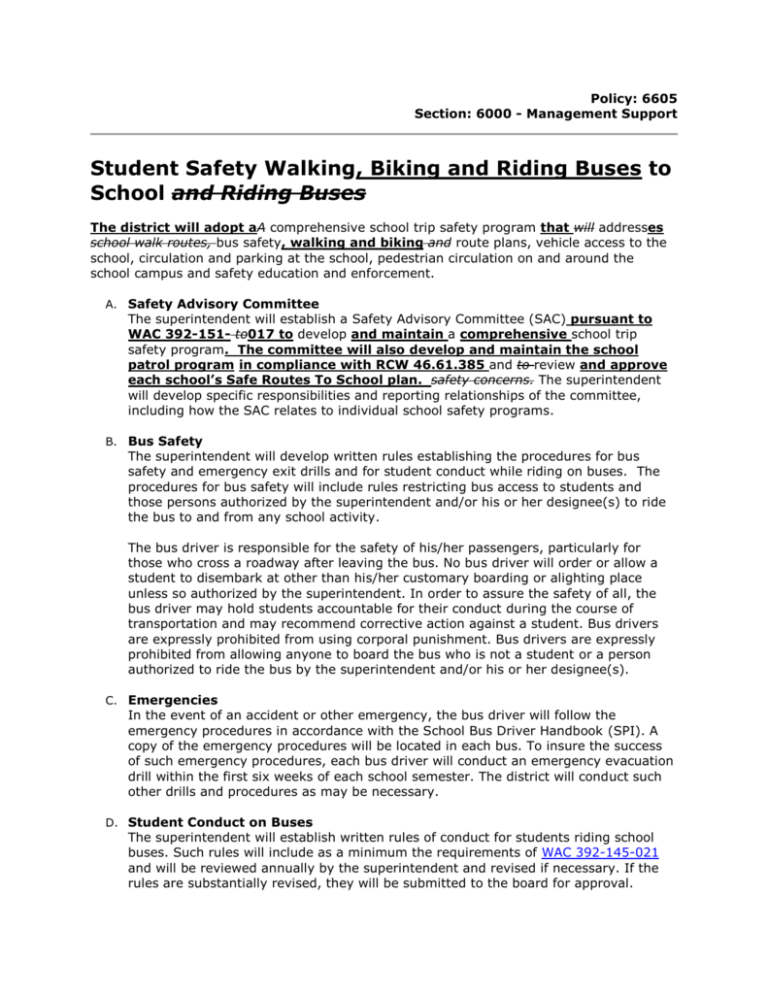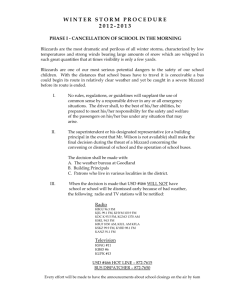
Policy: 6605
Section: 6000 - Management Support
Student Safety Walking, Biking and Riding Buses to
School and Riding Buses
The district will adopt aA comprehensive school trip safety program that will addresses
school walk routes, bus safety, walking and biking and route plans, vehicle access to the
school, circulation and parking at the school, pedestrian circulation on and around the
school campus and safety education and enforcement.
A. Safety Advisory Committee
The superintendent will establish a Safety Advisory Committee (SAC) pursuant to
WAC 392-151- to017 to develop and maintain a comprehensive school trip
safety program. The committee will also develop and maintain the school
patrol program in compliance with RCW 46.61.385 and to review and approve
each school’s Safe Routes To School plan. safety concerns. The superintendent
will develop specific responsibilities and reporting relationships of the committee,
including how the SAC relates to individual school safety programs.
B. Bus Safety
The superintendent will develop written rules establishing the procedures for bus
safety and emergency exit drills and for student conduct while riding on buses. The
procedures for bus safety will include rules restricting bus access to students and
those persons authorized by the superintendent and/or his or her designee(s) to ride
the bus to and from any school activity.
The bus driver is responsible for the safety of his/her passengers, particularly for
those who cross a roadway after leaving the bus. No bus driver will order or allow a
student to disembark at other than his/her customary boarding or alighting place
unless so authorized by the superintendent. In order to assure the safety of all, the
bus driver may hold students accountable for their conduct during the course of
transportation and may recommend corrective action against a student. Bus drivers
are expressly prohibited from using corporal punishment. Bus drivers are expressly
prohibited from allowing anyone to board the bus who is not a student or a person
authorized to ride the bus by the superintendent and/or his or her designee(s).
C. Emergencies
In the event of an accident or other emergency, the bus driver will follow the
emergency procedures in accordance with the School Bus Driver Handbook (SPI). A
copy of the emergency procedures will be located in each bus. To insure the success
of such emergency procedures, each bus driver will conduct an emergency evacuation
drill within the first six weeks of each school semester. The district will conduct such
other drills and procedures as may be necessary.
D. Student Conduct on Buses
The superintendent will establish written rules of conduct for students riding school
buses. Such rules will include as a minimum the requirements of WAC 392-145-021
and will be reviewed annually by the superintendent and revised if necessary. If the
rules are substantially revised, they will be submitted to the board for approval.
At the beginning of each school year, a copy of the rules of conduct for students riding
buses will be provided to each student who is scheduled to ride a school bus. The
classroom teacher and/or bus driver will review the rules with the students at or near
the beginning of each school year. A copy of the rules will be available upon request
at the district office.
E. Safe Routes To School Plan
Pursuant to WAC 392-151-025, all elementary schools that have students
who walk to and from school are required to develop a suggested route plan.
All schools are encouraged to have a walking/biking route plan in place. To
develop the school walking/biking route plans, the superintendent will
establish a Safe Routes to School committee.
The committee will conduct a walking and biking audit within a one mile
radius of the school and develop a Safe Routes To School walking/biking map
or plan. The plan will recommend the best routes for students walking to
and from school, as well as the best routes to and from school bus stops. In
developing the plan, the committee will consider, at a minimum, the
following:
1) traffic patterns;
2) existing traffic controls;
3) existing school patrols;
4) limits on the number of school crossings so that students have to move
through the crossings in groups;
5) allowing only one entrance-exit from each block to and from school;
6) routes that provide the greatest physical separation between walking
children and traffic;
7) routes that expose students to the lowest speeds and volumes of
moving vehicles; and
8) routes that include the fewest number of road or rail crossings;
The superintendent or designee will review the plan with the Safety Advisory
Committee and, upon its approval, distribute the plan to all students with
instructions that it be taken home and discussed with parents. The plan will be
routinely updated as conditions change. The superintendent or designee will
include the plan in the district’s School Wellness Plan to encourage parents and
students who walk and bike to school to use the recommended routes.
Cross References:
3241 - Classroom Management, Corrective Actions Or Punishment
6700 – Nutrition and Physical Fitness
Legal References:
RCW 28A.600.010 Enforcement of rules of conduct — Due process
guarantees — Computation of days for short-term and long-term
suspensions
RCW 46.61.385 – School patrol – Appointment –Authority –
Finance—Insurance
WAC 392-144 School Bus Driver Qualifications
WAC 392-145-016 Rules for students riding school buses
WAC 392-145-021 General operating requirements
WAC 392-151-017 Safety advisory committee - Selection
WAC 392-151-025 Route plans.
WAC 392-400-225 School district rules defining misconduct —
Distribution of rules
Management
Resources:
2014 – June Policy & Legal News Issue
The SRTS National Partnership Local Policy Guide
Adoption Date:
Classification: Discretionary Priority
Revised Dates: 02.06; 06.07; 12.11; 12.12; 06.14
2014 Washington State School Directors’ Association. All rights reserved.









